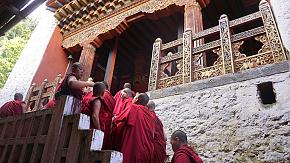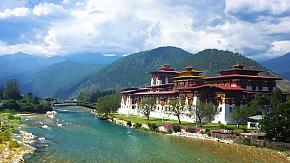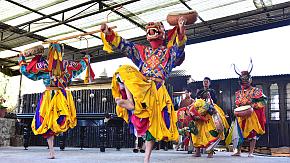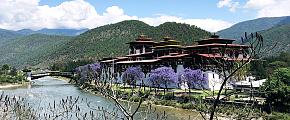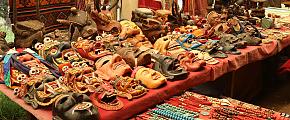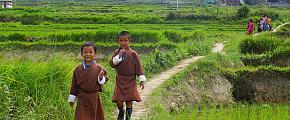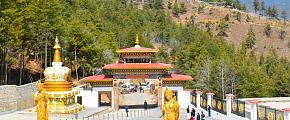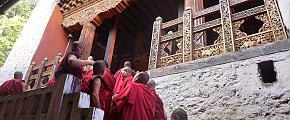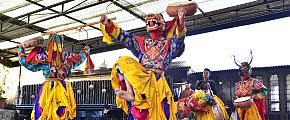Top 10 Attractions to Visit in Bhutan
Bhutan, lying in the south of the Himalayas, is a venerable country with a mysterious Buddhist culture. It is one of the least developed nations on earth, while also being regarded as one of the happiest, for the people of Bhutan follow a basic, pious Buddhist lifestyle that gives them self-sufficient joy.
Here you can see many "dzongs" surrounded by mountains, which are lama monastery buildings that serve as politics, religion, and law centers. Each dzong houses a large number of precious Buddhist statues and scriptures, representing the colorful aesthetics of Buddhist architecture, such as Paro Taktshang Goemba, one of the most famous in the world, with a long history and legends of mystery to explore. By visiting these dzong, you will be struck by the legends of one of the most influential religions in the world. What's more, on this small territory with undulating mountains, you will also see the rare animals and distinctive mountain landscapes of the Himalayas. Geographically or spiritually, Bhutan is an incomparable pure land in the world. This article will introduce the top 10 attractions to visit in Bhutan.
Punakha Dzong
Punakha Dzong is arguably the most beautiful dzong in Bhutan, as well as the capital and seat of Bhutan's government before the 1950s. It is located at the intersection of the Pho-chu and Mo-chu rivers, which means father river and mother river.
Founded in 1637, the main building of this magnificent dzong has six floors and a height of more than 200 meters, and other buildings of various sizes have two or three floors. The walls are densely carved with exquisite Buddhist patterns and hung with colorful Thangka paintings, which is the reason why these buildings look solemn and beautiful. Inside the dzongs are a great collection of precious murals and scriptures to display the history of Buddhism. Outside the dzong, you can see two limpid rivers meet, which are formed by melting snow from the Himalayas. The most breathtaking view comes in each spring when the purple jacaranda flowers are blooming delightfully on branches outside the red and white walls.
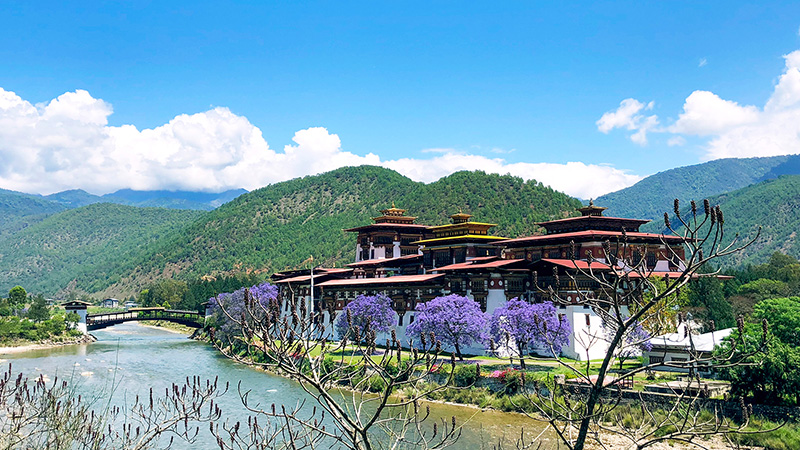 Punakha Dzong, Bhutan
Punakha Dzong, Bhutan
Tiger's Nest (Taktshang Goemba)
Paro Taktshang Goemba, also named Tiger's Nest, is a Buddhist temple with a history of more than 300 years, known as one of the top ten temples in the world. The temple, which was amazingly built on a cliff more than 3,000 feet high, was once seriously damaged in a fire and rebuilt in 1998. Here you can not only enjoy the splendid Buddhist culture, but also the beautiful mountains, forests, and idyllic scenery.
It is said that Guru Rinpoche, a Buddhist master, once flew over the cliff on a tigress and meditated inside the temple. It is surrounded by dozens of cypress trees, and the rocks at the bottom have already been covered with green mosses. It takes nearly 2 hours to walk from the foot to the temple, or you can rent a horse from the nearby horse gang and ride up the mountain.
Entering the complex, you can see Buddhist halls of different sizes, worshiping the statues of many important Buddhist figures, one of which is Dorje Drolo, the manifestation of the Guru Rinpoche assumed to have flown to Taktshang on a tigress. There is also Drubkhand, the cave where Guru Rinpoche meditated for three months.
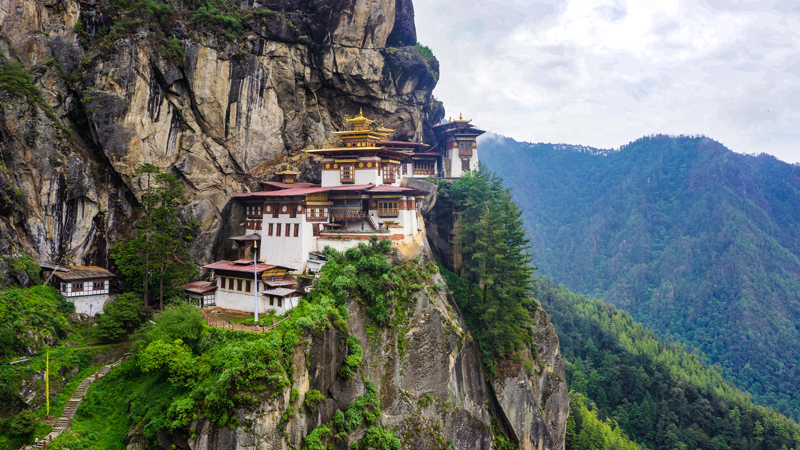 Paro Taktshang Monastery - Tiger's Nest
Paro Taktshang Monastery - Tiger's Nest
Paro Dzongkhag
Paro Dzong is located on the precipitous cliff of Paro's canyon, with a bubbling stream in front and picturesque landscapes nearby. The square white dzong against the blue sky and white clouds looks particularly solemn among the rows of houses around. Simply from the road to the gate of the dzong, the natural scenery along the way is already beautiful enough to take one's breath, let alone the landscapes inside the dzong. After entering it, you'll see Bhutan's most precious treasure, Thongdel, which is a scroll painting made of silk and cotton that depicts Guru Rinpoche and his two wives. People in Bhutan believe that as long as they worship this painting, they can reach the most desired state in Buddhism, Nirvana.
Motithang Takin Preserve
Bhutan has 72% land covered by forests, which makes it a natural habitat for many rare animals. Off the road leading to the BBS tower, the preserve is located in a primeval forest surrounded by mountains. Here you can see Takin, an animal with a head like a sheep and a body like a cattle, usually inhabiting the alpine forests and meadows above 2500 meters. As Bhutan's national animal, Takin is said to be created by a mad Buddhist master with the bones of sheep and cattle. The facilities in the park are quite simple, and its natural environment with thick coniferous vegetation is especially enjoyable on sunny days. Besides Takin, you can also see reindeer raised in the preserve.
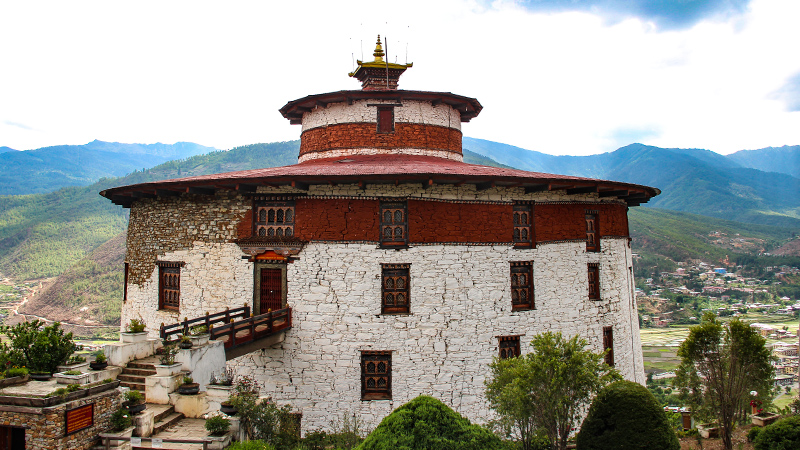
Buddha Dordenma
Located at the entrance of the Thimbu Valley, this is a giant Buddha statue in a sitting pose with a height of nearly 51 meters, completely made of bronze. The Buddha solemnly is seated on a three-layer base, and in front of it is a small chapel that houses thousands of donated small Buddha sculptures. Meanwhile, the Buddha himself also is a huge collection of Buddha sculptures, with 125,000 small Buddha statues inside the body. In the daytime, the vivid, merciful Buddha looks down upon the surrounding mountains and extending valleys; At night, the Buddha reflects a sacred golden light under the nearby illuminations. Either a pious Buddhist believer from other countries or a visitor attracted by reputation will be astounded by the magnificent smiling Buddha and leaves with a mind of peace.
Trashichhoe Dzong (Thimphu Dzong)
Located in Thimphu, Trashichhoe Dzong(also call Thimphu Dzong) is an ancient dzong that served as the office of the empire as well as the summer palace of the religious leader. Built-in the 13th century, it has buildings with classic white facades and golden roofs, most of which have two or three floors, solemnly lying on the plain of the picturesque Thimphu Valley. It's hard to find another national politics center in the world that is surrounded by verdant mountains and crossed by a gurgling river.
The complex contains more than 100 rooms, and mottled stone steps on both sides lead to the Lama's residence in the central square. Inside the Trashichhoe Dzong still are the throne and office of the king, as well as the conference hall where the royals held family conferences. Usually, after the empire and administrative staff leave work in the afternoon, tourists can enter the Trashichhoe Dzong to look around.
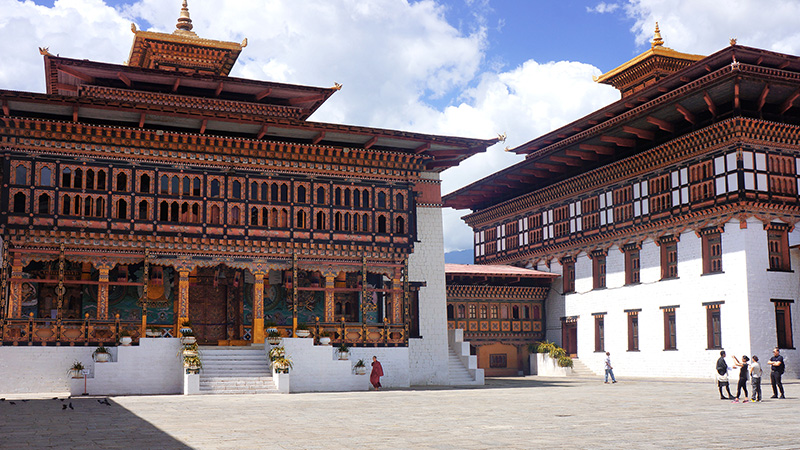 Thimphu Dzong
Thimphu Dzong
Gangte
Nearly 150 kilometers away from Thimphu, is a vast canyon area formed by glacial erosion, Gangte. It is a collection of winding streams, vast grasslands, and continuous green mountains, so it has become the best hiking destination in Thimphu. On sunny spring, the view along the hiking route is particularly beautiful, when wildflowers and grass are swaying everywhere. With any luck, you may come across the precious black-necked cranes, which are believed to bring harvest and tranquillity by the locals.
At the highest point of Gangte, you will encounter an ancient temple, the Gangte Goemba. This Buddhist temple built in the 15th century sits on a mountain with an altitude of nearly 2800 meters, the roof of which almost touches the blue sky. The magnificent complex includes temples, Buddhist academies, and a meditation center. All the wooden eaves are carved with colorful Buddhist patterns, and monks in magenta cassocks come and go through the quaint corridors.
In addition, if you like the natural beauty of Gangte and want to experience more of its natural part, it's recommended to stay in the Gangte Lodge, a hotel surrounded by mountains, for one night. It provides complete modern facilities, such as a fireplace, spa, and geothermal heating. Moreover, it offers local farm-life experiences.
Simtokha Dzong
Simtokha Dzong, built in 1626 by Ngawang Namgyel, is the oldest Dzong officially built in Bhutan as well as the first structure to incorporate both monastic and administrative facilities. The squat, white building has undergone a series of damages and expansions. Entering through the only gate on the south side, you can see the murals of the four kings, namely Vaishravana (north), Dhritarashtra (east), Virudhaka (south), and Virupaksha (west), protecting the four cardinal directions, and the vivid mongoose in the hand of the King of the North.
The Simtokha Dzong is now an important Buddhist school in Bhutan, where over 200 students study Buddhist culture and arts.
Kyichu Lhakhang
Kyichu Lhakhang, located in Paro, is one of the oldest temples in Bhutan. It consists of two temples, the first of which was built in 638 A.D. by Srong-btsan Sgam-po. There is a myth about the ancient temple: Long time ago, a female demon in Bhutan threatened people's lives. Later, Srong-btsan Sgam-po, king of ancient Tibet, established 108 temples to suppress the different parts of the demon's body, and the temple of Kyichu Lhakhang was exactly nailed to her left foot.
Back to the temple, the most venerable collection is a precious statue of 8-year-old Sakyamuni, which is worshiped by a constant stream of Buddhists every day. Another temple was organized and built by Queen Ashi Kesang in 1968 according to the pattern of the first one. There are also many precious Buddhist relics in the temple, such as the ashes of the Buddhist master H.H. Dilgo Khyentse Rinpoche.
National Museum
Located in Paro, Bhutan National Museum was once a watchtower and was transformed into a national museum in 1968. This circular building has a half-red and half-white facade that is more than two meters thick. Inside the round building mottled by years, over 3000 artifacts are housed, including ancient weapons, musical instruments, Buddhist statues, scriptures, Thang-ga paintings, etc. Walking around the museum, you will catch a glimpse of historical developments and changes in Bhutan through countless pieces of artifacts. Notably, Bhutan is also famous for stamps around the world, so the museum has a collection of pretty stamps printed with patterns like animals, plants, and various elements.
 Ta Dzong, National Museum of Bhutan
Ta Dzong, National Museum of Bhutan
As a shrine of Buddhism hidden in the Himalayas, the compact country of Bhutan has gradually revealed itself to the world in recent years. In its land with a little invasion of urban life, you can be totally away from disturbing work, seek the ancient Dzones hidden in the verdant valleys, explore the legends of the great Buddhist masters, and listen to your inner voice amid the fragrance of burning sandalwood. Later, come back to the valley scattered with greenness, take a breath of the fresh air and bathe in the mild sunshine. The next second, you will forget all the busyness and annoyance. Bhutan is a country you must visit once in your life.
Quick Question
Related Posts You May Like
What Our Clients Say
Explore the latest verified reviews of Odynovo's travel services on Tripadvisor, Google, Trustpilot, Product Review and more trusted platforms.

